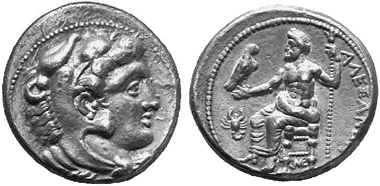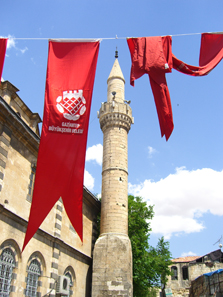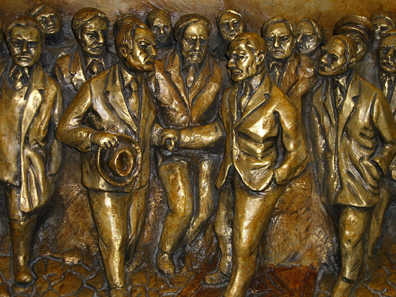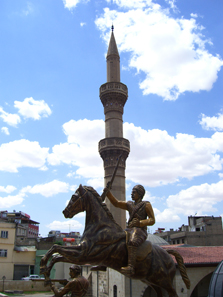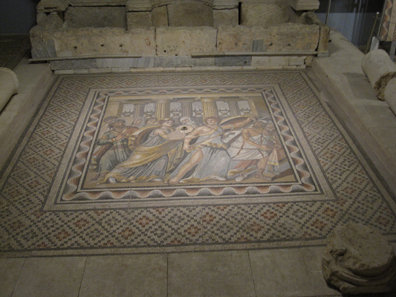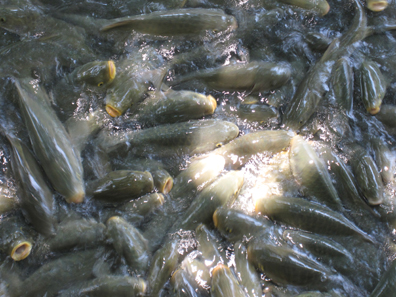by Ursula Kampmann
February 16, 2012 – Do you know Antep and its fabulous museum with mosaics? If not, I strongly recommend it to you. Antep is a pleasant town where you quickly feel at home. Urfa, ancient Edessa, in contrast, can’t be recommended for women traveling on their own. And if you do, you will need steady nerves.
View from the hotel’s terrace over the old town of Gaziantep. Photo: UK.
June, 19, 2009 – Gaziantep
I have a new favorite town in Turkey. It is called Gaziantep and, according to our clever book, is only worth a visit thanks to its new mosaic museum. Amazing how authors sometimes err.
Alexandria ad Issum. Bronze, 2nd cent. B. C. Head of Heracles. Rv. Zeus. SNG Levante 1834. From Münzen und Medaillen auction 19 (2006), 39.
At twelve noon we left Antakya. The bus was pretty empty when we left the city. Most of the passengers got on in Iskenderun, ancient Alexandreia kat’Isson. It is said to have been founded after the victory near Issos, to replace ancient Myriandros as key fortress to the Cilician-Syrian Gates.
Alexander the Great. Tetradrachm, Myriandrus, 330-325. Head of Heracles. Rv. Zeus on throne, in the field scorpion as mint mark. Price 3218. From Münzen und Medaillen auction 10 (2002), 192.
I didn’t find out anything more about the historical significance of the place. On the other hand, history isn’t the thing you are interested in when being here. Regarding to the economic importance, Iskenderun has outstripped ancient Antiochia. Iron and petroleum refining may not be especially attractive to the tourist passing by but it sustains the people living in the city. The short stop in Iskenderun was quite a detour from our trip to Gaziantep, but it was profitable for the bus company. And we got a marvelous ride over the saddle connecting the Syrian province with Cilicia out of it.
The ride took four hours. At 4 p.m. we arrived at Gaziantep. Our clever book had recommended a hotel situated directly at Atatürk Boulevard. Allegedly, mainly German engineers put up there. The rooms were said to be big, with a shower cabin (gosh, what an attraction!), and the rooftop terrace worth a stay. Hence, we booked a double room, although the staff at the reception asked us time and again if we didn’t prefer two single ones instead. Apparently, they had noticed the different family names on our passports. Well, well, we were approaching the pious East by now.
Gaziantep’s old town “toffed up” and expecting tourists. Photo: UK.
In the afternoon, we headed for the old town. It was overwhelming. For the first time in Turkey, we saw new signs on historical buildings stating the most important information concerning building history and importance of the building in three different languages (Turkish, Arab and English). Even the successful renovations were referred to: in 2008, for the most part. When strolling around the city with eyes open one realized that the mayor had made an effort to smarten his city up for the tourists. Thanks to the fabulous findings of Zeugma, Gaziantep had been provided the chance to become a tourist destination. And the city made great efforts to become an attraction!
Predecessor of Iuppiter Dolichenus: The Mesopotamian God of weather, Hadad, with double axe and thunderbolt. Photo: UK.
If Antep truly was ancient Antiochia in the Taurus Mountains? At any rate, the city of Doliche was situated not far away, the point of origin of the cult of Jupiter Dolichenus. And sorry, we didn’t make it there either. The present-day city came into being as fortress after the Battle of Manzikert after the Seljuks had expelled the Byzantine people. It became famous due to its occupation after World War I – later, we will come back to that. We found a comfortable tea garden where we took a seat for a short break, for dinner we discovered a fancy restaurant with Italian cuisine (by now, we were getting tired of eating kebabs all the time) and enjoyed the Turkish hospitality again and again.
Welcome to a Turkish Migros. Photo: KW.
Oh well, we experienced something reminiscent of home in addition: we did some shopping in a Migros – that’s right, a Swiss Migros, but Turkish style. They even had M Budget, albeit for 10 kilo buckets yoghurt and alike. The Turks were truly put out when we started taking pictures in the supermarket. They couldn’t understand our excitement, not by any stretch of imagination.
Writing on the diary on the hotel terrace. Photo: KW.
We spent the evening high above the city sitting on the hotel terrace that really was remarkable. Some Germans actually sat behind us (presumably engineers). I got my Raki, we ate a water melon and were completely enthralled by the city.
Our cordial relationship with Gaziantep was slightly dulled in the late evening. I had locked myself in the bathroom and was stuck all of a sudden. The lock was blocked so that I couldn’t open it from the inside anymore. A horrible sensation! If I had been alone, I would have been forced to sleep in the (rather narrow) john and most possibly would have been found by the chambermaid the next day. But Kurt was there and forced the door open. Good thing was that everything was flimsily built around here (however, it was not as easy as it might sound). It made a racket, the lock flew off the door and I was free at last.
In the bazaar. Photo: UK.
June 20, 2009 – A splendid museum
In the morning, we strolled around the old town where we saw water sellers with their huge copper jugs strapped to their backs and the simit sellers carrying a plate with circular sesame breads on top of their heads. We came to the citadel again, wanted to visit it and, finally after a long period of searching, found the entrance, albeit not the courtyard. The citizens of Gaziantep had set up a new museum in the last years.
Atatürk in the middle of his allies. Relief in Antep’s museum. Photo: UK.
Gazi-Antep was simply called Antep once. It was awarded the honorific title “Gazi” (brave warrior) during the Turkish War of Independence in the aftermath of World War I. After the Armistice of Mudros on October 30, 1918, that brought the hostilities between the Ottoman Empire and the Allied Forces to a close, the French army, on ground of a secret arrangement with the British, invaded Cilicia and neighboring Southern Anatolia. On November 17, roughly 15,000 volunteers mainly of the French Armenian Legion arrived and occupied the harbors. In 1919, Antep, Maras and Urfa were taken and, as stipulated in the contract, handed over to the British. There was a considerable resistance from the local citizens against the invaders. The situation was complicated by the fact that many Armenians cooperated with the French. Soon, the French and Britons were amidst partisans because in the meantime, the trouble had increased throughout the country.
Kemal, who wasn’t yet Atatük by the time, had called the soldiers for resistance and had started to reorganize the country and to retake it for a democratically governed Turkish people. This is not the place to reconstruct in every detail the many military actions involved. Suffice it to say to Maras managed to get free again at the beginning of 1920. Urfa successfully did the same in April, whereas in Antep the upheaval cost 6,000 lives and still ended without success.
The French government, however, realized how high the price would be for holding the territory. It reached an agreement with the Young Turks and retreated from the occupied territories, leaving approximately 100,000 Armenian refugees, which had been resettled in Cilicia as late as 1920 and had cooperated with the French occupants – that was a heavy load for the future ahead.
Even today Antep celebrates itself as town of the heroes. Photo: UK.
Be that as it may, the Turkish confidence is still fueled by the then gained heroic fame. Gaziantep aims to exploit this glorious heritage for tourism and has thus set up a museum, in addition to the numerous monuments of the great fighters for independence, which recalls the fight of the city from the view of the Turkish Nationalists.
Heroism at the museum’s entrance. Photo: UK.
Being a Western European, coming from a country that has lost World War II, I found all this heroism a bit awkward. Already at the entrance two warriors with moustaches aimed at the visitors entering. Horses reared, children died bravely and there was a name stated on the basis of every life-size (but not necessarily true-to-life) statue.
The museum was situated in the castle. On display were not exhibits, but modern, somewhat naïve copper reliefs with illustrations of the War of Independence. There were detailed explanatory texts in Turkish and English.
Execution of children. Photo: UK.
Sometimes I didn’t know what to say, like, for example, about the gruesome slaughter of 14 Turkish boys, which – admitteldly – had brought supplies, ammunition and food, to a franctireur corps engaged in open battle with the French. The boys with their pack animals got caught in the middle. They entrenched themselves in a mill. Due to fire exchange they didn’t manage to transport the supplies to the fighting Turks. The Turks, therefore, were forced to pull back. They abandoned their young helpers to their fate. The French stormed the mill and killed the 14- to 15-year-olds. The text stressed reproachfully that the boys didn’t carry any arms.
River gods. Mosaic in the archaeological museum of Antep. Photo: UK.
We spent a more edifying afternoon in the magnificent Archaeological Museum of Gaziantep. I don’t remember having viewed any mosaics like these in my life – and I have seen quite a few. The museum was bursting at the seams even though it housed only the highlights from a comparably small excavation area!
Achilles disguised as girl reveals himself reaching for weapons. Mosaic in the archaeological museum of Antep. Photo: KW.
Let’s recall: they come from Zeugma, which was flooded at the command of the Turkish government in 2000 to dam water for watering the fields of Anatolia. The finds were unearthed during an emergency excavation the son of the founder of Hewlett Packard had conducted at his own expense. He had read about the imminent catastrophe in the New York Times and funded the emergency excavation. It cost five million dollars and brought mankind incredible treasures which otherwise would have been lost in the floods of the reservoir dam.
Mosaic of Zosimus in the archaeological museum of Antep. Photo: KW.
The President delayed the flooding for ten days. It would have taken years to retrieve all the precious finds. Sad truth is, however, that governments all over the world sacrifice cultural property recklessly to economic interests.
Detail of the mosaic of Zosimus. Photo: UK.
By the way, Zeugma had been founded by Seleukos I where the first bridge crossed the Euphrates River. In 64 B. C., the Romans conquered the city. It was an important commercial and administrative center with roughly 80,000 citizens. Zeugma was situated at the Silk Road. The great camel trains passed by here. The soldiers of Legio IV Scythica were stationed there as well and brought Roman habits to Mesopotamia. In 256, Shapur I seized the city; the concomitant destructions and an earthquake shortly thereafter terminated the golden age of Zeugma.
All the posters of the museum show this woman’s face. Photo: UK.
Let’s get back to the museum! Such an abundance of subjects! Ranging from Achilles hiding amongst the maidens to evade dying in Troy, to Daidalos building the wooden cow for Pasiphae, to Klio and Kaliope, to Dionysos and Poseidon – there seemed to be no end to it, one mosaic more gorgeous and precious than the other.
The coin exhibition of Gaziantep. Photo: UK.
And they had coins! In Zeugma a treasure of Syrian Tetradrachms had been found and – hard to believe indeed! – was cataloged and published. The leaflet was available for purchase in the museum shop (that’s right, we even found a museum shop in Gaziantep! They even had postcards!). We discovered a catalog of seal imprints of the city as well.
Seal imprints from Zeugma. Photo: UK.
The hitherto biggest number of seal imprints had been found in Zeugma. They were classified, well photographed, and likewise published in a leaflet. The museum shop not only offers books but good coin replicas as well. I wonder how much time it will take for the first ones to show up on eBay – with the ‘copy’ specification erased, of course.
We spent more than 2.5 hours in the museum before heading back to the hotel, but not without having a try of Gaziantep’s most important confectionary first. It is said that it is here where the best pistachios grow and the best Baklava is produced. Accordingly, we found ourselves a confectionary shop to try Baklava. I should have known: it looks terrific but its sweetness is hard to stand for a Central European tongue. We ate courageously and hurried to our toothbrushes afterwards to prevent our teeth from instantly falling out due to the amount of sugar.
June 21, 2009 – In Mesopotamia
In the morning we departed for Sanliurfa – Urfa was likewise awarded a nice epithet (Sanli means holy) for its participation in the Wars of Independence, which, by the way, is rarely used in every-day language. We were lucky. The man at the ticket office was so kind to ask his colleague as to when his bus would leave because he could only offer at twelve noon. So we took the “Tatlises” line at half past ten. “Talises” is an important business man in Turkey who raised from a simple worker to a show star and earned so much money in that sector that today he owns bus lines, snack bars and so on. His business methods are rather debated. Yellow press has it that he had hired someone – mafia style – to smash the skull of his mistress and sent contract killers to several opponents.
It may fit that on March 14, 2011, an anonymous person fired at him… The assassin escaped with his heavy-calibered machine gun, but only a few days later a gangland boss, known to the police, was suspected and taken into custody. By that, we have said too much too early (note written during the preparation of the publication).
At any rate, that man knows to promote himself: the whole bus ride long his old TV shows were broadcasted – giving us Western bus tourists a good impression as to who is worshipped as super star in Turkey: we saw a Turkish “Musikantenstadel” with folk music: gentlemen in folkloric attire, all of them with thick moustaches and prominent bellies – displayed themselves, shaking their hips and flicking their fingers. In Germany stars like these would only be sneered at as men with a midlife crisis – here, in contrast, young girls wacked out once corpulent Mr. Sweet Voice – that’s what “Tatlises” means – turns his yearning organ on. It was neither a feast for the eyes nor the ears. But ideals of beauty are always culture-bound.
The fortress of Urfa. Photo: KW.
Around noon we arrived at Urfa. For once we knew exactly which hotel we wanted to stay in. There is a new super-duper hotel near the fish ponds called El Ruha. Actually not only the hotel was pleasingly nice, but the staff was polite and surprisingly skilled. With aplomb they told us that the roughly 100 hotel rooms were booked without exception. What a disappointment!
At least they were extremely polite, and they even got us a room in another hotel. That, however, was a flop. The Dedeman Hotel was one of these typically Turkish wannabe hotels that charge American four-star prices without having the faintest idea what a four-star hotel should offer. The air conditioner did some noise but that was it.
The fish ponds of Urfa. Photo: UK.
We went into town for a start and had the impression that our hotel was situated in the middle of nowhere – far from it, we had only made several detours. Urfa was full of people going for an excursion to the popular fish ponds of Abraham. It is a green oasis that had come into being near a big Islamic sanctuary. Tradition has it that Abraham had been born in Urfa. At the age of 16 he tried to proselyte King Nimrod who, as punishment, let him burn at the stake. But – as our guidebook puts it – “The Lord will not cast off his own people.” The stake turned into a pond, the embers within turned into carps which luxuriate until the present day. After all, eating them will result in immediate blindness.
Thousands of carps live in the ponds of Urfa. Photo: KW.
And so incredible numbers of these sacred animals splash about in small streams and basins and are fed by the visitors.
Water trucks carry the precious liquid into the recreation area. Photo: UK.
Actually, one ought to thank Nimrod for he has provided the reason to create an oasis here. Near countless fountains and watercourse one sits in the cool whereas the rest of the city is boiling due to temperatures up to 45 degrees in the shade. We sat down in one the teahouses, watches the families occupying the tables for hours and consuming so little during that time.
Rowing on the small ponds is great fun for the visitors. Photo: UK.
We watched all the little princes and princesses playing rambunctiously without being rebuked for it. We watched the two little boats doing their small tour of five minutes in the biggest of the fish ponds. It was interesting, calming and relaxing – just what we needed.
But: it drove me crazy that everyone stared at my legs. I wasn’t dressed improperly at all, no. Considering the 45 degrees I had put half-length trousers that exposed half of my (please note) lower legs. And everyone stared, men, women, children. Until we got the trick. Whenever a woman or child gazed at me I only had to stare back, equally pushy. Then the other party immediately looked down. With men, however, that didn’t work. They weren’t deterred by my stare. In such a case I jogged Kurt’s elbow, he gazed which settled the matter at once.
By early evening, we decided to look for the travel agency that organized trips to Nemrud Dagh, as our guidebook informed us. I was about to give up – all maps of the world concede to the victory to the Oriental chaos – but, finally, we found it, and so world famous Nemrud Dagh was on our agenda for the next day. I hope for you to accompany us on the next issue of this journey’s diary.
You can read all other parts of this diary here.






